Back to Journals » Psychology Research and Behavior Management » Volume 13
Based on Computational Communication Paradigm: Simulation of Public Opinion Communication Process of Panic Buying During the COVID-19 Pandemic
Authors Li Q , Chen T, Yang J , Cong G
Received 7 September 2020
Accepted for publication 19 October 2020
Published 20 November 2020 Volume 2020:13 Pages 1027—1045
DOI https://doi.org/10.2147/PRBM.S280825
Checked for plagiarism Yes
Review by Single anonymous peer review
Peer reviewer comments 3
Editor who approved publication: Professor Einar Thorsteinsson
Qianqian Li,1 Tinggui Chen,2 Jianjun Yang,3 Guodong Cong4
1School of Management and E-Business, Zhejiang Gongshang University, Hangzhou 310018, People’s Republic of China; 2School of Statistics and Mathematics, Zhejiang Gongshang University, Hangzhou 310018, People’s Republic of China; 3Department of Computer Science and Information Systems, University of North Georgia, Oakwood, Georgia 30566, USA; 4School of Tourism and Urban-Rural Planning, Zhejiang Gongshang University, Hangzhou 310018, People’s Republic of China
Correspondence: Tinggui Chen Tel +86-152-681-34776
Email [email protected]
Background and Aim: The spread of the COVID-19 pandemic has led to a number of instances of large-scale panic buying. Taking the COVID-19 pandemic as an example, this paper explores the impact of panic in uncertain environments on panic buying behavior. Under certain circumstances, the spread of rumors about shortage of goods is likely to cause large-scale panic buying. This paper focuses on the study of such panic buying caused by online rumors.
Methods: Firstly, based on the improved BA network, this paper constructs a directed network for public opinion communication and integrates an offline communication network to build a two-layer synchronous coupling network based on online and offline communications. Secondly, the individual decision model and the panic emotion transmission model under the uncertain environment are constructed. Netizens judge the authenticity of network information, determine their own panic degree according to the above two models, and judge whether they participate in the panic buying based on the above factors. Finally, the spread of the public opinion of goods buying under the panic state is simulated and analyzed.
Results: The experimental results of the two-layer synchronous network that integrates offline interaction are significantly different from the results of pure online interaction, which increases the speed of public opinions spread after offline interaction and affects a wider range of groups. Under the condition of sufficient supplies, panic in local areas will not cause large-scale panic buying on the whole network. However, the results under the same parameters suggest that if there is a shortage of supplies, panic will spread quickly across the network, leading to large-scale panic buying. It is very important to ensure sufficient supply of materials at the beginning of the spread of rumors, which can reduce the number of buyers. However, if there is a shortage of goods before the panic dissipates in the later stage, there will still be a large-scale rush purchase.
Conclusion: These results explain the reasons why it is difficult to stop the buying events in many areas under the COVID-19 pandemic. Under the uncertain environment, the panic caused by people’s fear of stock shortage promotes the occurrence of large-scale rush buying. Therefore, in the event of major public health events, ensuring adequate supply of materials is the top priority.
Keywords: panic buying, public opinion transmission, two-layer synchronous coupling network, COVID-19 pandemic, computational communication
Introduction
In 2020, the COVID-19 pandemic caused a lot of panic buying around the world. Due to the lack of transparency of information in many countries and regions, people were full of panic or even scared due to uncertain information and then proceeded to hoard goods.1 People in the United States, Italy, and other countries have hoarded a great number of life supplies, epidemic prevention supplies, and medicine. Even supplies unrelated to epidemic prevention were snapped up in some countries, such as “ShuangHuangLian” medicine in China, granite in Japan, and toilet paper in Italy. During normal times, mass panic buying would disrupt the commodity supply chain and make government management more difficult.2 Many public health events, such as the COVID-19 pandemic, can easily delay or even disrupt the supply chain, and large-scale panic buying events at this time can easily lead to the overall scarcity of social materials. Therefore, it is of great significance to study the current situation and influencing factors of panic buying and explore the deep reasons of panic buying.
Panic buying is an emerging phenomenon observed during but not restricted to pandemics.1 Panic buying generally refers to the abnormal consumption behaviors of a group,3 which are caused by a specific natural disaster or social event and are concentrated due to the perception of panic under the premise of information opacity. Therefore, they are characterized by uncertainty and panic.4 Panic behavior during disaster and calamities is an expected response; they threaten the ability to cope, and destroy the existing equilibrium.5 In panic buying, as a result of social interaction, groups will communicate panic information such as the impending shortage of goods with each other, further interact with their own opinions, and even transmit panic feelings to each other. At the same time, the uncertainty of social information will further deepen the fear of individuals. Therefore, under the influence of herd mentality or panic infection, some individuals tend to hoard materials, which eventually lead to large-scale panic buying events.6
Panic buying easily disrupts the supply chain and wastes a large amount of resources, greatly harming society. The literature on group buying behavior research usually deals with the analysis of psychological factors or economics explanation,7 focusing on the meaning of the data but lacking a calculation model. Literature8 pointed out that only 32 results were obtained by searching literature in Scopus with the keywords “contain panic buying” by early 2020. By studying these documents, it can be found that the current research on panic buying behavior is not complete, only conducting basic study, and has not formed a mature research system. Most of these studies use multiple linear regression or structural equation models to explore the relationship between the target variables, some studies use such qualitative analysis methods as negotiation to study the problem, and a few use quantitative analysis methods. Although these studies can theoretically explain the causes of the panic buying phenomenon, they cannot restore the overall change process of the panic buying phenomenon from gestation to development and regression, and lack of intuitiveness and evidence. Therefore, it is still an unsolved problem to establish an appropriate mathematical model for panic group buying behavior. The effective use of mathematical models can make the complex and changeable network public opinion problems more intuitive and clear.
Based on this, by combining public opinion transmission mechanism of panic, this paper tries to analyze mass buying behavior caused by panic, and makes improvement based on the traditional Susceptible-Infected-Recovered model (SIR).9 Also, this paper blends the particularity of panic buying public opinion to establish a new transmission model, and analyzes the goods panic buying caused by the spread of panic in the uncertain environment with the calculation of simulation experiment.
The structure of this paper is as follows: Literature Review is literature review, pointing out the innovation of this paper; Model Construction constructs the online transmission model of panic buying public opinion and further proposes the improved SIR model for public opinion transmission and the offline interaction behaviors to build a two-layer synchronous network; Simulation Experience uses computer simulation methods to analyze the factors affecting the public opinion transmission of material buying; the section headed Examples gives some cases to support the model; and, finally, Conclusion and Future Work gives the summary of the whole paper and the future research direction.
Literature Review
At present, there is very limited research on panic buying. Some typical literatures are as follows: Yuen et al8 provided a comprehensive explanation for the reasons of panic buying by integrating limited and scattered literatures, and pointed out that there was a lack of researches on panic buying at present. Rosnow and Rosenthal10 proposed that emergencies would seriously threaten the basic operation of the social system, so both the government and citizens had to respond in the case of strong timeliness and uncertainty. Zheng et al2 put forward that under such circumstances, consumers who were uncertain about the consequences of disruption often stockpiled large amounts of products to mitigate the risk of future shortages. The shortage analysis was carried out from the perspective of supply chain. Kang et al11 suggested that the media’s depiction of people’s panic buying might lead to people’s distrust of society and subsequently lead to more panic buying. Arafat et al12 put forward that the media play a significant role in dealing with panic buying as some of the psychological explanations are related to the perception of the general population. Therefore, in prevention, the media could play a vital role.
Panic buying is a kind of impulsive consumption behavior. At present, there have been a lot of studies on it. For example, Shiv and Fedorikhin13 proposed that impulsive consumption behavior was the result of the game between people's desire to buy and their self-control. Sarah and Arthur14 proposed that negative emotions were an important incentive for impulsive consumption, and individuals often adjusted and alleviated their negative emotions through impulsive or even retaliatory shopping. Bosch and Stern7 believed that impulse buying is influenced by a series of economic, time, place, and even cultural factors, and consumers who implemented impulse buying were often affected by strong and even irresistible impulse buying motivation. Weinberg15 believed that impulsive consumption was an irrational behavior in which consumers had a strong emotional response to the stimulus in the shopping situation, and then took an immediate response without thinking.
In the event of an emergency, it is often difficult for people to have enough time to make a reasonable decision, and individuals tend to be influenced by emotionality and conformity in their behavior. Therefore, due to the irrational characteristics of impulsive consumption and material panic buying behavior, many scholars try to study panic buying behavior from the emotional perspective. For example, Sharma and Alter16 proposed that individuals often bought scarce commodities not because of the value contained in them, but of emotional psychological needs. Aguirre17 believed that panic is a social behavior during a crisis, which was irrational, anti-social, and selfish, and pointed out that panic was hard to control and seriously affects consumers’ behavior. Kemp et al18 proposed that uncertainty would cause people’s fear, and the emergence of fear psychology would lead to purchasing behavior. Anand19 pointed out that risk perception referred to the individual’s perception and cognition of external objective risks, emphasizing the influence of individual experience gained through subjective judgment on individual perception, which was used to express the attitude and intuitive judgment of objective risks, including the assessment and response to risks. Sheu and Kuo20 proposed that hoarding prior to or during a disaster could be interpreted as a form of self-protection behavior.
Many scholars believe that panic emotions can be mutually infected. For example, Hatfield et al21 proposed that emotional contagion was the result of an individual’s unified emotion by learning or imitating different information such as other individuals’ language. Du et al22 believed that emotional infection was a process of unconscious expression and transmission of similar emotions. Hoffman23 believed that emotional infection was the emotional cognition and control formed by conscious performance. Therefore, conformity is also a factor that induces purchasing behavior. Deutsch and Gerard24 divided conformity into informational conformity and normative conformity. The former referred to conformity conducted by an individual following the opinions of others, while the latter referred to the phenomenon that an individual keeps his own behavior consistent with others' in order to meet the expectations and norms of others or groups.
In addition, some scholars have studied the purchasing behavior caused by disasters in real life. For example, George25 studied the panic buying caused by the September 11 attack in the United States, and proposed that the panic buying in this event was the consumption behavior taken by people to protect themselves against terrorism. Soon26 explored the cognition and trust of Malaysian consumers on food safety news conveyed by social media through a questionnaire, and proposed that fake food safety news released by social media might cause mass panic. Forbes6 took the Christchurch earthquake in 2011 as an example to make an in-depth study of the changes in consumer preferences after disasters. Sawada et al27 investigated the changes of household consumption behavior in rural Philippines after Tropical Storm Milenyo. Kennett-Hensel et al28 studied the effect of consumer behavior of victims of Hurricane Katrina on emotional recovery from the perspective of consumer psychology, and further analyzed the impact of their life attitudes on purchasing power. Danielle29 discussed the panic caused by the 2009 H1N1 pandemic.
After the outbreak of the COVID-19 pandemic in 2020, many scholars analyzed the public health event. By collecting the information from the English media reports published till 22nd May, Arafat et al1 evaluated the nature, extent, and impact of panic buying on traditional media reports. They also pointed out that the media should be more cautious and responsible when reporting panic buying behavior. Minihan et al30 conducted a study on the psychological problems caused by the global epidemic of COVID-19, suggesting that certain groups, such as people with mental illness, were particularly vulnerable during the pandemic and that governments need to provide maximum support to this group and their families. Arafat et al4 pointed out that, since ancient times, panic buying behavior had been observed in public health emergencies. However, there was no exact psychological explanation for this. So, taking the COVID-19 pandemic as the entry point, they explored the psychological factors behind panic buying behavior of the masses during the epidemic, and proposed that fear of material scarcity and insecurity were the core factors that cause panic buying. Hobbs31 discussed the impact of panic buying and hoarding behaviors on social stability in Canada during the COVID-19 pandemic from the perspective of supply chain resilience. Kerr32 pointed out that the COVID-19 pandemic put unprecedented pressure on Canadian food supply chains. The first need was to focus on maintaining and enhancing supply chain resilience.
From the above analysis, it can be seen there are only a few studies on panic buying at present, and most scholars try to explain panic buying from the perspective of impulsive consumption, but there is a lack of heterogeneous studies of the panic state. In fact, panic buying is fundamentally different from other buying behaviors. However, the research on the spread of panic emotion only exists in the perspective of theoretical analysis, and empirical research is lacking. There are few studies on the use of panic transmission theory to describe impulsive consumption. Regarding the particularity of panic buying public opinion, this paper tries to analyze the panic buying behavior caused by panic in combination with the communication mechanism of public opinion. Firstly, the traditional model of infectious disease spread was improved, and the susceptible person (S), infected person (I), and Immune person (R) in the SIR model. So, the model conforms to the rules of public opinion transmission in panic buying. Secondly, by integrating the particularity of panic buying public opinion, we established a new model of panic buying public opinion transmission. Finally, the problem of material buying caused by panic emotion under uncertain environment is analyzed through computational simulation experiment.
Model Construction
This paper quantifies the panic buying behavior through the “Agent Based Model” (ABM) method.33 The ABM method is a microscopic model, which can reproduce and predict complex phenomena by simulating the simultaneous actions and interactions of the multiple agents. This process is the emergence from the low micro to the high macro. In the paper, the individual who participates in the spread of panic on the network is represented as an agent. Set the network scale to be N, that is, there are N netizen nodes in the network. The individual attitude value in the network is represented by any number in the continuous interval [−1,1], and its initial attitude value follows the random value of uniform distribution. As shown in Figure 1, each node in the network represents the individual participating in the public opinion transmission, and is represented as an agent in the model. In each interaction, the two individuals with connection relationship have a certain probability to interact with each other.
 |
Figure 1 Local network connection diagram. |
Specific research methods are shown in Figure 2. In this paper, we construct the panic transmission model and the occurrence judgment model to determine whether the individual will choose to participate in the rush purchase. At the same time, through the construction of an online and offline double-layer synchronous coupling network, we compare the impact of virtual network and offline life on individuals in the rush purchase event.
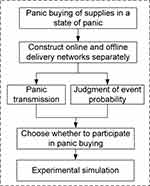 |
Figure 2 Research method. |
Conviction of Shortage Probability
Panic buying behavior refers to a kind of anti-risk behavior of some fearful individuals in society who feel threatened in the uncertain environment and perceive a scarcity of goods and materials. After an emergency occurs, individuals will form a series of opinions on the event after perceiving the information, and reach a certain consensus after mutual discussion, which is called panic buying public opinion. Then, panic buying public opinion urges individuals to take actions. As a result, offline panic buying events occur.
The most critical factor in the formation of panic buying public opinion is the individual’s judgment of the possibility of shortage at the next moment. However, due to the butterfly effect,34 the occurrence of each event is caused by multiple factors. In the same way, individual perceptions of specific events are composed of multiple factors. Taking the public opinion of buying rice in China in May 2020 for example, the arguments for buying rice in the public opinion include: China’s grain self-sufficiency rate reaches more than 80%; Vietnam and other major grain exporters restrict the export of grain; the face mask shortage event in early 2020 and the opinions of the friends around. Everyone’s view of panic buying is a combination of all panic buying and opposing views.
Banisch and Olbrich35 put forward that the transformation of individuals from belief to attitude was realized through a coded cognitive evaluation graph. The facts of different dimensions affect their separate attitude judgment in their own dimensions. In addition, they proposed a multi-dimensional belief evaluation model to study multi-dimensional attitude transformation. Based on this model, this paper proposes a multi-dimensional opinion formation model suitable for panic buying public opinion.
As shown in Figure 3, the model assumes that every individual’s opinion of the possibility of shortage at the next moment is composed of n arguments. It assumes that some of these arguments support panic buying while some do not. For example, the argument that “China’s grain self-sufficiency rate reaches more than 80%” would not support panic buying, while the argument that “Vietnam and other major grain exporting countries restrict the export of grain” would support panic buying. However, these arguments are independent of each other, namely, China’s grain self-sufficiency rate of 80% is not correlated with Vietnam’s export restriction. Therefore, assuming that the decision space “ ” of agent i composed of n independent elements, shown as:
” of agent i composed of n independent elements, shown as:  .
.
 |
Figure 3 Formation model of multi-dimensional opinion. |
Therefore, it is assumed that agent i can judge the probability of shortage based on the information found and define it as Ri. Its value can be calculated as follows:
From the above analysis, we can know that Ri . In addition, when individuals interact with each other on panic buying public opinions, they will believe that the information delivered by those who have similar opinions to themselves is more trustable.36 Therefore, individual j’s persuasion degree over i is positively correlated with the degree of similarity between the interlocutors. The degree of similarity between two individuals can be expressed by the repetition degree of each argument. If Ijk=Iik≠0, it means that both individual i and individual j have certain opinions on argument k, and their opinions are consistent, that is, they have similar opinions on argument k. Assuming the parameter κij is the number of Ijk=Iik≠0 (k=1~n) at time t, the conviction function Rij of individual i to j can be calculated as
. In addition, when individuals interact with each other on panic buying public opinions, they will believe that the information delivered by those who have similar opinions to themselves is more trustable.36 Therefore, individual j’s persuasion degree over i is positively correlated with the degree of similarity between the interlocutors. The degree of similarity between two individuals can be expressed by the repetition degree of each argument. If Ijk=Iik≠0, it means that both individual i and individual j have certain opinions on argument k, and their opinions are consistent, that is, they have similar opinions on argument k. Assuming the parameter κij is the number of Ijk=Iik≠0 (k=1~n) at time t, the conviction function Rij of individual i to j can be calculated as
Note:
As shown in Formula 5 and Figure 4, at time t, the information of agent j is transmitted to agent i and has influence on agent i. Assuming that there is a threshold δ, if κij is greater than δ, agent i will believe that the opinion of agent j is trustable. Therefore, at the next moment, i will choose to modify his opinion by referring to agent j’s opinion.
 |
Figure 4 Changes of individual opinion. |
Coefficient of Panic
Mass panic buying is a group behavior driven by panic emotion. Individuals in an uncertain environment will produce a series of psychological reactions, the most obvious of which is panic.37 When individuals with low risk perception feel the risk in the network and start to worry about the lack of materials, they will also spread the panic while buying goods and materials, so as to spread the panic and trigger large-scale panic buying behavior. Based on this, panic can be contagious. When in a panic state, agent j will continue to spread panic emotion to the outside, leading to other individuals falling into panic. Suppose the panic coefficient of agent i at time t is expressed as Ei(t) (Ei(t)∈[0,1]). At this point, due to the panic emotion conveyed by agent j, the panic degree of agent i at the next moment changes. In addition, the level of individual panic is also affected by uncertainty. After the occurrence of public health and other emergencies, if the government fails to convey effective information in a timely manner or the government information is not transparent enough, individual panic will rise. Therefore, the degree of panic is also related to uncertainty, which is specifically calculated as follows:
where parameter C represents the conformity of the individual, representing the degree of individual i is affected by the panic emotion of others; the parameter ε represents the degree of uncertainty perceived by the individual.
Panic Buying Selection
The panic buying behavior of individuals in the panic state is jointly influenced by the shortage probability Ri(t) and the panic coefficient Ei(t) judged by the individuals themselves. Artificial potential field theory38 holds that individual behaviors of social networks can be described by constructing artificial potential field functions, which are specifically represented by searchers finding and reaching target information points according to potential difference. When agent j passes an opinion to agent i, agent j transmits his judgment about the probability of a shortage, the Rj, and the panic coefficient, the Ej. Specifically, agent j exerts gravity on agent i, through the artificial potential field, and agent i is affected and changes accordingly. Figure 5 shows the artificial potential field of panic buying public opinion, and the shaded part is the buying interval. When the agent i opinion xi (Ei, Ri) is within the buying interval, it means that i participates in the buying behavior.
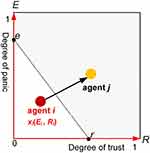 |
Figure 5 Individual panic buying selection. |
According to mathematical information, node xi (Ei, Ri) is located in the non-panic buying interval of the figure under the constraint conditions as follows:
where the parameters e and r represent the threshold value of the panic coefficient Ei and the panic probability Ri in the panic buying interval.
Based on this, the activation function of an individual’s buying behavior can be represented by the Boolean variable Si(t):
where Si(t)=1 represents that individuals participate in the panic buying, and Si(t)=0 represents that individuals do not participate in the panic buying.
In addition, the specific value of individual i’s opinion on whether to hoard materials at time t can be quantified as |xi| of vector value x, which is expressed as follows:
Process of Public Opinion Communication
The biggest difference between panic buying public opinion and the rest of the public opinion is that the lack of materials tends to make individuals worry about their own survival, so it is extremely inflammatory. Suppose that at the beginning there are rumors of shortages and some individuals start to be panic and join in the panic buying. As shown in Figure 6 and above, supposing there is a threshold k1 (k1 [0,1]), if the agent i’s opinion points value |xi|<k1, it is assumed that individuals determine not to buy goods, that is, they are immune to this event and are regarded as (R). The remaining individuals are represented as susceptible (S) and infected (I). Individuals in these two states are participating in the transmission and interaction of panic buying public opinion on the Internet. Assuming individuals with
[0,1]), if the agent i’s opinion points value |xi|<k1, it is assumed that individuals determine not to buy goods, that is, they are immune to this event and are regarded as (R). The remaining individuals are represented as susceptible (S) and infected (I). Individuals in these two states are participating in the transmission and interaction of panic buying public opinion on the Internet. Assuming individuals with  =1 (calculated by Formula 8) are infected persons, these individuals, who have a negative impact on offline material inventory, participate in offline panic buying besides network interaction directly. Therefore, individuals with
=1 (calculated by Formula 8) are infected persons, these individuals, who have a negative impact on offline material inventory, participate in offline panic buying besides network interaction directly. Therefore, individuals with  0 are denoted as susceptible (S).
0 are denoted as susceptible (S).
 |
Figure 6 Individual panic buying state. |
As shown in Figures 7 and 8, at the initial moment in a network with N individuals a certain number of nodes are in panic and participate in panic buying, which are regarded as infected persons (I) at first stage, and the neighboring nodes connected directly with these infected persons are susceptible persons (S) at second stage. Taking Figure 8 for example: if agent a is feeling panic and becoming the first one of the infected group, so the panic emotion will be transmitted downward by the agent a. So, the individuals connected with agent a become the first susceptible group. The first susceptible group had different opinions on the panic buying due to their individual heterogeneity dimensions. After judgment, these individuals differentiated into a new generation of infected people (S), susceptible people (I), and immune people (R). A new generation of infected and susceptible people spreads the panic message, while the immune people exit the public opinion interaction process.
 |
Figure 7 Nodes status. |
 |
Figure 8 The process of panic spread. |
Construction of Communication Network
Another difference between panic and other public opinions is that individuals can easily verify truth through offline life. When individuals contact others with information about stock shortages online, they do not immediately believe it. However, when they make onsite investigations offline, such as in supermarkets and retail stores, if they find that there is indeed a risk of stock shortage, their awareness of stock shortage and the level of panic will be greatly deepened. Therefore, the analysis of panic buying public opinion must have offline network analysis.
Due to the virtual characteristics of the network, the objects of its network interaction are very different from that in reality, which is manifested in different connection modes. As shown in Figure 9, in the communication process of public opinion, there are synchronous coupling relationships between online and offline interaction. Assuming that all above nodes are natural person nodes, the edge represents the social connection relation of the node, and the presence of an edge represents the presence of interaction opportunity. It is worth noting that the same number of nodes in the figure indicates the same individual, so there is a strict synchronization between the individual opinions in the online connection and the offline connection. In other words, every individual has both online network and offline network.
 |
Figure 9 Two-layer synchronous coupling network. |
Due to the virtual characteristics of the Internet, the objects of its network interaction are very different from the interactors in reality, which is manifested in different connection modes. As shown in Figure 8, in the communication process of public opinion, there exists synchronous coupling relationship between online and offline interaction. Assuming that all the above nodes are natural persons, the edge represents the social connection relation of the node, and the presence of an edge represents the presence of interaction opportunity. It is worth noting that if the nodes in both images have the same number, they are the same natural person, so there is a strict synchronization between the individual opinions in the online connection and the offline connection. In other words, every individual has both online network and offline network.
In addition, previous researches on network public opinion behaviors usually construct static networks and conduct interactions based on the interaction rules given by nodes on static networks.39 However, the whole communication process of online public opinion is dynamic and changeable. Any hot network event spreads from the first batch of communicators until it begins to ferment until meeting the super-communicators, and gradually becomes known to the public. Therefore, more individuals can interact in the network constructed by these communicators, thus achieving the emergence of public opinion. Based on this, this paper uses complex network theory to build a new public opinion communication network.
Specific model construction is as follows:
Step 1: Online network construction.
1) Construct the initial network: the initial network node is set as m0, and random connection is adopted between nodes.
2) The growth method of network nodes: once each new node in the network is added, the connection relationship is established with m nodes in the initial network. That is, when each new addition of m edges occurs, the connection probability of the newly added nodes connecting the nodes in the initial network is positively correlated with the degree of the original nodes until the total number of all nodes in the network is N (note: m<m0).40,41 At this point, the network is an undirected network graph with N nodes, and the network connection is shown in Figure 10A.
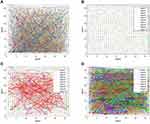 |
Figure 10 The schematic diagram of network construction process. |
3) Directed network setting: selecting two nodes with connection relationship in the network, such as agent i and agent j, counting di and dj. If di<dj, it is set as that agent i focuses on agent j (Pij=1), and the Pji of agent j is calculated as follows:
Step 2: Offline network construction.
1) Marking of local networks: n nodes in the network were randomly divided into n types and marked (for simple calculation, n was set to 10 in this paper, so all nodes above were marked as: 1,2,3 … 10), as shown in Figure 10B.
2) Formation of region network: nodes marked as 1 are extracted. According to the above analysis, there are N/n nodes in total, and the probability that every two points are connected is p1. This is shown in Figure 10C.
3) Repeating it for the (n-1) times. At this point, every node in the network connects with other nodes with the same mark. At this point, the connection of offline network is segmented and isolated, which conforms to the regional characteristics of offline interaction, as shown in Figure 10D.
Step 3: Select the initial infected person: randomly selecting N0 nodes in the network and setting the reliability R and panic degree E of these nodes to 1. Therefore, risk status value of these nodes at the initial moment is S, who spreads panic as the first disseminators in the network.
Step 4: Spread of panic: setting the proportion of online and offline interaction for each node. According to Formulas 1–10, the risk status of neighbor nodes who concerned with the first communicators is calculated respectively. If the node state is S or I, it will continue to spread panic and participate in the interaction. If the individual state is R, it will completely stop interaction. That is, all the connections of the node will be disconnected, making it an isolated node. It is noteworthy that the number of individuals in R state will increase continuously with the evolution process.
Step 5: Repeatedly update the panic status until the end of evolution time. According to the above evolutionary steps, at time t, NK(t), the number of people who know the event at this point is:
The density of individuals participating in the panic buying behavior at time t in the whole network is:
Based on the above analysis, the evolution process of this paper is shown in Figure 11.
 |
Figure 11 Evolution process. |
Simulation Experience
This section discusses the factors that cause panic buying behavior through different interactive networks and regional panic transmission.
Online Panic Spread
In this section, based on directed network generated by Formulas 1–10 and Step 1 to Step 5, panic buying public opinions on the Internet are simulated. The number of nodes in the simulated network N is 1000, the average path length is 5.4454, the clustering coefficient is 0.0048, and the average degree is 3.133. Assume that the number of infected persons at the initial time NS(0) is 50, that is, these nodes account for 5% of the total nodes in the simulation experiment. Figure 12 shows the simulated panic public opinion transfer process.
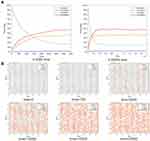 |
Figure 12 Simulation of online panic public opinion transmission process. |
It can be seen from Figure 12 that at time∈[1,1500], along with the spread of panic buying public opinion, the number of informed people in the network increases rapidly and is divided into infected group, susceptible group, and a small number of immune group. After time=1500, the growth of the number of informed persons slowed down and reached a stable level at time=4000.
Contrast of Two Network Panic Transmission
At this time, the offline panic spread process is fused with the online one, that is, nodes in the network participate in two kinds of interaction at the same time. Since individuals participate in network interaction more frequently, it is assumed that the frequency of these nodes participating in online and offline interaction is 10:1 (i.e. only when time=10k, k∈{1,2,3,4 … } is offline interaction). The calculation results are shown in Figure 13.
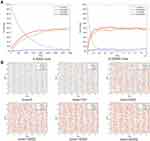 |
Figure 13 Simulation of dual online panic public opinion transmission process. |
Based on the comparison between Figures 12 and 13, and by comparing with the simulation of solo online public opinion, the public opinion consolidated with offline interaction spreads faster. At the same time, when the social attitude is constant, the number of infected people and susceptible people participating in the discussion of the panic buying event is also higher.
In order to explore the causes of the above changes, the data were reconstructed and the experiment was carried out. In the case of the same parameters, the frequency of individuals participating in offline interaction was changed to explore their changes, as shown in Figure 14.
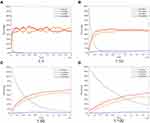 |
Figure 14 Simulation of panic public opinion transmission process under different interaction frequencies. |
As can be seen from Figure 14, with the increase of offline interaction frequency, the speed of public opinion transmission is accelerated and the scope of transmission is wider. The reason lies in that the interaction objects of online connection and offline connection are different, while the increase of offline connection objects promotes the further diffusion of public opinion.
The Influence of Panic in a Single Region on the Whole Network
The transmission process of panic public opinion is complex and changeable, involving many factors, such as different supply quantity among different regions, or different psychological factors such as individual conformity, and different factors may lead to different results. However, these seemingly isolated offline nodes can interact with each other through online interaction. Therefore, a large-scale outbreak of panic in a region can indirectly affect the public opinion of the whole society, which in turn leads to large-scale panic buying.
Suppose that when panic buying public opinions spread, some individuals in region 1 would participate in panic buying. However, the suppliers in region 1 did not supply in time and the rest of the individuals witnessed offline shortages. Consequently, their panic activation function Si(t) was activated.
To facilitate the analysis of the extreme case, assumed here, all the individuals in region 1 thought they had to buy goods and materials (that is, the proportion of individual region 1 in the state of S accounts for 100%). At time t=0, these individuals convey their opinions to other individuals through the network. After enough opinions are exchanged across the network, the proportion of individuals in the state of S in the network changes as shown in Figure 15.
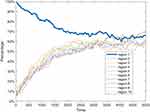 |
Figure 15 The proportion of individuals buying up from different regions with the changes of time. |
As can be seen from Figure 15, when only a few regions in the network are in a state of panic, if the material supply of rest regions is sufficient, the whole network will not be in a state of panic. After enough time, the nodes in the region that were initially in a state of panic will reduce.
However, when numerous individuals participate in the panic buying, it is extremely difficult to ensure that all areas are adequately supplied. Offline material supply is likely to fall into shortage with the increase of individuals in S state, while the shortage of material supply will in turn lead to the continuous increase the number of individuals in S state and get into a vicious cycle. In this paper, Formula 12 defines the proportion of individuals participating in the panic buying at time t as  . Assuming the threshold is
. Assuming the threshold is  , when
, when  , it is likely to be out of stock in the network. Suppose that if
, it is likely to be out of stock in the network. Suppose that if  and
and  are directly proportional to
are directly proportional to  , the modified Formula 2 and Formula 6 are calculated as follows:
, the modified Formula 2 and Formula 6 are calculated as follows:
The supplementary Formulas 13–14 are retested, and the results are shown in Figure 16:
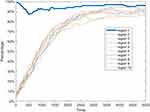 |
Figure 16 The proportion of individuals buying up from different regions with the changes of time when the supply is not timely. |
As Figure 16 shows, in the case of insufficient supplies, panic in a few areas can have an impact on the whole society. Therefore, it is necessary to ensure adequate supplies when rumors of shortages spread widely on the Internet.
Examples
We studied the corresponding news and found that the real phenomena match our simulation results. In our simulation, we derived the outcomes that individuals’ face-to-face interaction promotes the transmission of panic in a certain degree. For instance, initially, the COVID-19 pandemic took off in Washington State and California in the USA in early March 2020. The two states had about 1000 confirmed cases and 32 deaths of the disease. Because of few confirmed cases and deaths in other areas in the USA, the panic in other states was not much at that time. Meanwhile, the USA did not carry out shutdown or enforce the order of mandatorily wearing facemasks. However, people’s face-to-face interaction came alive over the two states, and resulted in panic shopping. People were talking with each other and were stocking up on soap, hand sanitizers, and alcohol wipes because they believed that the stuff can protect them from being infected with the virus. The offline interaction pushed the spread of panic, and then many people began to post their concerns of the virus and their actions of panic buying on local social networking platforms, such as Nextdoor, which is a neighborhood hub for trusted connections and the exchange of information in the local region. Soon after, many people posted their opinion on Facebook and Twitter, making the panic spread to all over the USA, even to the areas that had very few confirmed cases and deaths. As it turned out, the offline interaction promoted the transmission of panic.
In our simulation, we also found that the large-scale outbreak of panic in an area will indirectly affect the public opinion of the entire society, and then result in large-scale panic buying. For example, the mid-center China reported the outbreak of the COVID-19 pandemic at first. Then panic buying emerged at some cities in China mainland. Soon after, rumors started that Hong Kong will be short of groceries such as toilet paper because it imports most of the goods from China mainland. Therefore, some people in Hong Kong began their crazy buying for various goods, especially for toilet paper and sanitizers. At the same time, social media in Japan erroneously posted that toilet paper and groceries were running low, as China would no longer supply these products, leading to panic buying in Japan as well. In Singapore and Australia, the toilet paper started disappearing in supermarkets and panic buying even led to people fighting in the checkout queue. These examples illustrate that the panic affects the public opinion over the whole society, and in turn incurs large-scale panic buying.
Moreover, we found that when numerous instances of panic buying take place in a local area, it is necessary to ensure plenty of supplies in other regions, otherwise it will cause the entire society to fall into panic buying. For example, when panic buying occurred in a few states in the USA, such as Washington state and California, people in many other states were flocking to supermarkets as well. Shoppers not only stocked up sanitizers and toilet paper, but also swept food, bottled water, even TV sets and bicycles. People’s behavior in this manner made shortages worse. The effective strategy is to offer sufficient materials in supermarkets. Costco, Walmart, and Kroger, the three large-scale retailers with many supermarkets in the USA, dispatched goods from their warehouses or called in supplies from the manufacturers in a short time. On the other side, the US government gave the retailers many preferential policies in terms of taxation, circulation, and commerce to help them provide enough goods to consumers. Consequently, the panic buying was calmed down and people’s lives returned to regular order. Figure 17 is the simulation of public opinion on panic goods rush purchase in this paper.
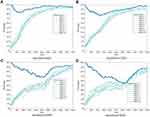 |
Figure 17 Under the condition of different out of stock time, the proportion of individuals in rush purchase changes with time. |
It can be seen from Figure 17 that in the initial stage of public opinion transmission, ensuring sufficient supply of materials can reduce the number of individuals participating in the rush buying. However, if comparing with Figure 17(A–D), it is not difficult to see that their convergence is similar when time=5000 after material shortage. This shows that before the end of the panic buying public opinion, if there is a lack of material supply, the number of rush buyers will rise rapidly. This explains the reason why it is difficult to stop the buying events in many areas during the COVID-19 pandemic.
Therefore, in the event of major public health events, ensuring adequate supply of materials is the top priority.
Conclusion and Future Work
Conclusion
In a specific environment, the spread of rumors of shortage will easily lead to large-scale panic buying. In this paper, the online and offline two-layer synchronous coupling network is constructed, and on this basis the material panic model is constructed to analyze the influencing factors of panic public opinion transmission.
The main work of this paper is as follows:
(1) Based on the classic BA network, the online directed public opinion transmission-network is constructed, and the offline transmission-network is integrated to construct the public opinion transmissionmodel based on the online and offline two-layer synchronous coupling network.
(2) The individual decision model and the panic transmission model under the uncertain environment are constructed.
(3) Simulation results show that: 1) The offline interaction of individuals promotes the transmission of panic to a certain extent; 2) When there is large-scale panic buying in local areas, it is necessary to ensure sufficient supplies in other areas, otherwise the whole society will fall into a state of panic buying.
The Limitations and Some Suggestions for Future Research
(1) This paper proposes that group panic is related to uncertainty. However, the deep reasons for the transmission of group panic caused by uncertainty remain to be further studied. At present, the research on behavior choice of micro individuals in uncertain environment represented by DS evidence theory (proposed by Dempster and Shafer)42 has achieved preliminary results, and its combination with network public opinion is of great research value.
(2) In fact, the transformation of panic emotion generated by micro individuals and macro public opinion is a very complex process, so it is necessary to explore the relationship between them in future research. Using psychological theory to explain this may be a possible method.
(3) There is a virtual feature in the network, which makes it difficult for individuals to distinguish the induced stock out rumor information. With the constant disclosure of the truth, the phenomenon of public opinion reversal appears from time to time. In the study of panic buying, there are still few literatures on public opinion reversal. But the phenomenon of public opinion reversal is a very important and urgent problem to be solved.
(4) The artificial intelligence algorithm based on big data greatly strengthens the attributes of human social relations. The rise of social computing, which takes communication network analysis, communication text mining, and so on as the main analysis tools, has provided some assistance for the computability foundation of human communication behavior. Therefore, through the analysis of human communication behavior data contained in the Internet big data, we can deeply mine the patterns and rules behind human communication behaviors, and analyze the generation mechanism and basic principles behind the patterns.
Data Availability
The datasets generated and analyzed during the current study are available from the corresponding author.
Funding
This research is supported by the National Social Science Foundation of China (Grant No. 20BTQ059).
Disclosure
The authors declare that they have no competing interests.
References
1. Arafat SMY, Karb SK, Menonc V, et al. Panic buying: an insight from the content analysis of media reports duringCOVID-19 pandemic. Neurology, Psychiatry Brain Research. 2020;37:100–103. doi:10.1016/j.npbr.2020.07.002
2. Zheng R, Shou B, Yang J. Supply disruption management under consumer panic buying and social learning effects. Omega. 2020. doi:10.1016/j.omega.2020.102238.
3. Slovic P, Peters E. Risk perception and affect. Curr Dir Psychol Sci. 2006;15:322–325. doi:10.1111/j.1467-8721.2006.00461.x
4. Sneath JZ, Lacey R, Kennett-Hensel PA. Coping with a natural disaster: losses, emotions, and impulsive and compulsive buying. Mark Lett. 2009;20:45–60. doi:10.1007/s11002-008-9049-y
5. Arafat SMY, Kar SK, Marthoenis M, Sharma P, Apu EH, Kabir R. Psychological underpinning of panic buying during pandemic (COVID-19). Psychiatry Res. 2020;289:113061. doi:10.1016/j.psychres.2020.113061
6. Forbes SL. Post-disaster consumption: analysis from the 2011 Christchurch earthquake. International Review Retail, Distribution Consumer Research. 2017;27:28–42.
7. Bosch RVD, Stern VM. The integration of chemical and biological control of arthropod pests. Annu Rev Entomol. 1962;7(1):367. doi:10.1146/annurev.en.07.010162.002055
8. Yuen KF, Wang X, Ma F, Li K. The psychological causes of panic buying following a health crisis. Int J Environ Res Public Health. 2020;17(10):3513. doi:10.3390/ijerph17103513
9. Chen T, Shi J, Yang J, Cong G, Li G. Modeling public opinion polarization in group behavior by integrating sirs-based information diffusion process. Complexity. 2020;2020: Article ID 4791527. doi:10.1155/2020/4791527.
10. Rosnow RL, Rosenthal R. Statistical procedures and the justification of knowledge in psychological science. American Psychologist. 1989;44(10):1276–1284. doi:10.1037/0003-066X.44.10.1276
11. Kang I, He X, Shin MM. Chinese consumers’ herd consumption behavior related to Korean luxury cosmetics: the mediating role of fear of missing out. Front Psychol. 2020;11:121. doi:10.3389/fpsyg.2020.00121
12. Arafat SMY, Kar SK, Kabir R. Possible controlling measures of panic buying during COVID-19. Int J Ment Health Addict. 2020. doi:10.1007/s11469-020-00320-1.
13. Shiv B, Fedorikhin A. Heart and mind in conflict: the interplay of affect and cognition in consumer decision making. J Consumer Research. 1999;26(3):278–292. doi:10.1086/209563
14. Sarah MW, Arthur K. Negative Affect: the dark side of retailing. J Bus Res. 2003;56(7):553–559. doi:10.1016/S0148-2963(01)00245-4
15. Weinberg S. Cosmological constraints on the scale of super symmetry breaking. Phys Rev Lett. 1982;48(19):1303–1306. doi:10.1103/PhysRevLett.48.1303
16. Sharma E, Alter AL. Financial deprivation prompts consumers to seek scarce goods. J Consumer Research. 2012;39(3):545–560. doi:10.1086/664038
17. Aguirre BE. Emergency evacuations, panic, and social psychology . Psychiatry-Interpersonal Biological Processes. 2005;68(2):121–129. doi:10.1521/psyc.2005.68.2.121
18. Kemp E, Pamela A, Kennett H, Williams KH. The calm before the storm: examining emotion regulation consumption in the face of an impending disaster. Psychology Marketing. 2014;31(11):933–945. doi:10.1002/mar.20744
19. Anand P. Decision-making when science is ambiguous. Science. 2002;295(5561):1839. doi:10.1126/science.1061744
20. Sheu JB, Kuo HT. Dual speculative hoarding: A wholesaler-retailer channel behavioral phenomenon behind potential natural hazard threats. International J Disaster Risk Reduction. 2020;44:101430. doi:10.1016/j.ijdrr.2019.101430
21. Hatfield E, Cacioppo J, Rapson RL. Emotional contagion . Curr Dir Psychol Sci. 1993;2(3):96–99. doi:10.1111/1467-8721.ep10770953
22. Du J, Fan X, Feng T. Multiple emotional contagions in service encounters . J Academy Marketing Science. 2011;39(3):449–466. doi:10.1007/s11747-010-0210-9
23. Hoffman ML. How automatic and representational is empathy, and why. Behavioral Brain Sciences. 2001;25(1):38–39. doi:10.1017/S0140525X02410011
24. Deutsch M, Gerard HA. Study of normative and informational social influences upon individual judgment. J Abnorm Soc Psychol. 1955;51(3):629–636. doi:10.1037/h0046408
25. George T. The S6 kinase signaling pathway in the control of development and growth. Biol Res. 2002;35(2):305.
26. Soon JM. Consumers’ awareness and trust toward food safety news on social media in Malaysia. J Food Prot. 2020;83(3):452–459. doi:10.4315/0362-028X.JFP-19-415
27. Sawada Y, Estudillo JP, Fuwa N, How KK. Do People Cope with a Natural Disaster? The Case of Super Typhoon Milenyo in the Philippines In Development, Natural Resources and the Environment. G P, eds. Los Banos: University Philippines: Carnaje and L. S. Cabanilla; 2009:116–150.
28. Kennett-Hensel PA, Sneath JZ, Lacey R. Liminality and consumption in the aftermath of a natural disaster. J Consumer Marketing. 2012;29(1):52–63. doi:10.1108/07363761211193046
29. Danielle O. The emotional epidemiology of H1N1 influenza vaccination. New England J Medicine. 2009;361(27):2594–2595. doi:10.1056/NEJMp0911047
30. Minihan E, Gavin B, Kelly BD, McNicholas M. Covid-19, mental health and psychological first aid. Ir J Psychol Med. 2020;1–5. doi:10.1017/ipm.2020.41.
31. Hobbs JE. Food supply chains during the COVID-19 pandemic. Canadian J Agricultural Economics. 2020;68(2):171–176. doi:10.1111/cjag.12237
32. Kerr WA. The COVID-19 pandemic and agriculture: short-and long-run implications for international trade relations. Canadian J Agricultural Economics. 2020;68(2):225–229. doi:10.1111/cjag.12230
33. Schelling TC. Dynamic models of segregation. J Math Sociol. 1971;1(2):143–186.
34. Lorenz EN. Deterministic nonperiodic flow. J Atmos Sci. 1963;20:130–141. doi:10.1175/1520-0469(1963)020<0130:DNF>2.0.CO;2
35. Banisch S, Olbrich E. An argument communication model of polarization and ideological alignment. Physics Society. 2020. https://www.researchgate.net/publication/327717834.
36. Chen T, Li Q, Yang J, Cong G, Li G. Modeling of the public opinion polarization process with the considerations of individual heterogeneity and dynamic conformity. Mathematics. 2019;7(10):917. doi:10.3390/math7100917
37. Khan S, Huremović D. Psychology of the pandemic. Psychiatry Pandemics. 2019;37–44. doi:10.1007/978-3-030-15346-5_3.
38. Khatib O. Real-time obstacle avoidance for manipulators and mobile robots. Int J Rob Res. 1986;5(1):90–99. doi:10.1177/027836498600500106
39. Li J, Xiao R. Agent-based modelling approach for multidimensional opinion polarization in collective behaviour. J Artificial Societies Social Simulation. 2017;20(2):14. doi:10.18564/jasss.3385
40. Barabási A, Albert R. Emergence of scaling in random networks. Science. 1999;286(5439):509–512. doi:10.1126/science.286.5439.509
41. Chen T, Wang Y, Yang J, Cong G. Modeling public opinion reversal process with the considerations of external intervention information and individual internal characteristics. Healthcare. 2020;8(2):160. doi:10.3390/healthcare8020160
42. Dempster AP, Laird NM, Rubin DB. Maximum likelihood from incomplete data via the EM algorithm. J Royal Statal Society. 1977;39(1):1–38.
 © 2020 The Author(s). This work is published and licensed by Dove Medical Press Limited. The full terms of this license are available at https://www.dovepress.com/terms.php and incorporate the Creative Commons Attribution - Non Commercial (unported, v3.0) License.
By accessing the work you hereby accept the Terms. Non-commercial uses of the work are permitted without any further permission from Dove Medical Press Limited, provided the work is properly attributed. For permission for commercial use of this work, please see paragraphs 4.2 and 5 of our Terms.
© 2020 The Author(s). This work is published and licensed by Dove Medical Press Limited. The full terms of this license are available at https://www.dovepress.com/terms.php and incorporate the Creative Commons Attribution - Non Commercial (unported, v3.0) License.
By accessing the work you hereby accept the Terms. Non-commercial uses of the work are permitted without any further permission from Dove Medical Press Limited, provided the work is properly attributed. For permission for commercial use of this work, please see paragraphs 4.2 and 5 of our Terms.
















